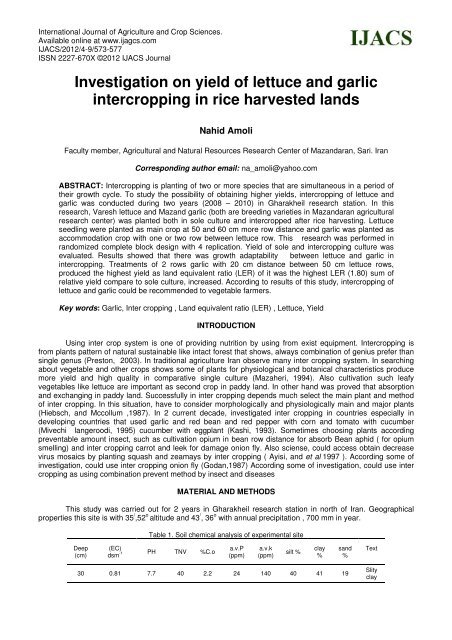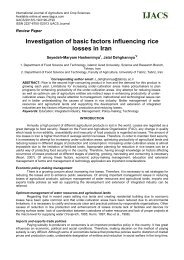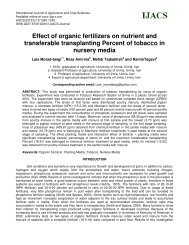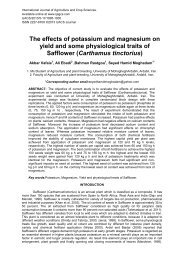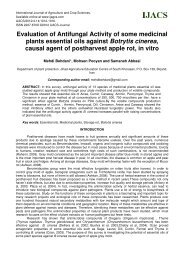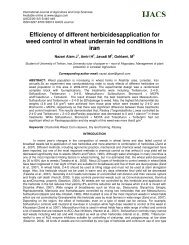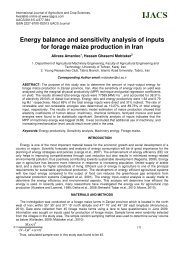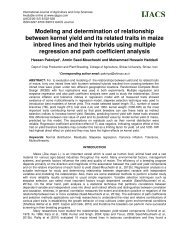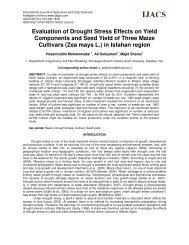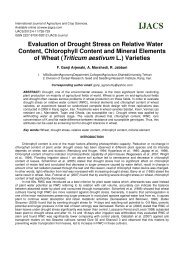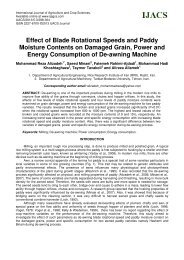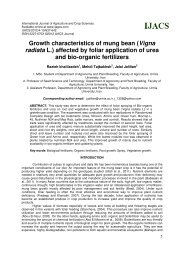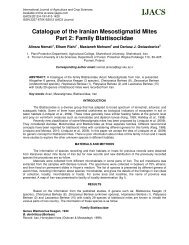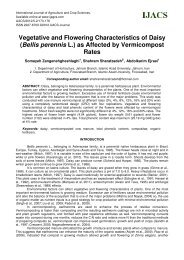573-577 - International Journal of Agriculture and Crop Sciences ...
573-577 - International Journal of Agriculture and Crop Sciences ...
573-577 - International Journal of Agriculture and Crop Sciences ...
Create successful ePaper yourself
Turn your PDF publications into a flip-book with our unique Google optimized e-Paper software.
<strong>International</strong> <strong>Journal</strong> <strong>of</strong> <strong>Agriculture</strong> <strong>and</strong> <strong>Crop</strong> <strong>Sciences</strong>.<br />
Available online at www.ijagcs.com<br />
IJACS/2012/4-9/<strong>573</strong>-<strong>577</strong><br />
ISSN 2227-670X ©2012 IJACS <strong>Journal</strong><br />
Investigation on yield <strong>of</strong> lettuce <strong>and</strong> garlic<br />
intercropping in rice harvested l<strong>and</strong>s<br />
Nahid Amoli<br />
Faculty member, Agricultural <strong>and</strong> Natural Resources Research Center <strong>of</strong> Maz<strong>and</strong>aran, Sari. Iran<br />
Corresponding author email: na_amoli@yahoo.com<br />
ABSTRACT: Intercropping is planting <strong>of</strong> two or more species that are simultaneous in a period <strong>of</strong><br />
their growth cycle. To study the possibility <strong>of</strong> obtaining higher yields, intercropping <strong>of</strong> lettuce <strong>and</strong><br />
garlic was conducted during two years (2008 – 2010) in Gharakheil research station. In this<br />
research, Varesh lettuce <strong>and</strong> Maz<strong>and</strong> garlic (both are breeding varieties in Maz<strong>and</strong>aran agricultural<br />
research center) was planted both in sole culture <strong>and</strong> intercropped after rice harvesting. Lettuce<br />
seedling were planted as main crop at 50 <strong>and</strong> 60 cm more row distance <strong>and</strong> garlic was planted as<br />
accommodation crop with one or two row between lettuce row. This research was performed in<br />
r<strong>and</strong>omized complete block design with 4 replication. Yield <strong>of</strong> sole <strong>and</strong> intercropping culture was<br />
evaluated. Results showed that there was growth adaptability between lettuce <strong>and</strong> garlic in<br />
intercropping. Treatments <strong>of</strong> 2 rows garlic with 20 cm distance between 50 cm lettuce rows,<br />
produced the highest yield as l<strong>and</strong> equivalent ratio (LER) <strong>of</strong> it was the highest LER (1.80) sum <strong>of</strong><br />
relative yield compare to sole culture, increased. According to results <strong>of</strong> this study, intercropping <strong>of</strong><br />
lettuce <strong>and</strong> garlic could be recommended to vegetable farmers.<br />
Key words: Garlic, Inter cropping , L<strong>and</strong> equivalent ratio (LER) , Lettuce, Yield<br />
INTRODUCTION<br />
Using inter crop system is one <strong>of</strong> providing nutrition by using from exist equipment. Intercropping is<br />
from plants pattern <strong>of</strong> natural sustainable like intact forest that shows, always combination <strong>of</strong> genius prefer than<br />
single genus (Preston, 2003). In traditional agriculture Iran observe many inter cropping system. In searching<br />
about vegetable <strong>and</strong> other crops shows some <strong>of</strong> plants for physiological <strong>and</strong> botanical characteristics produce<br />
more yield <strong>and</strong> high quality in comparative single culture (Mazaheri, 1994). Also cultivation such leafy<br />
vegetables like lettuce are important as second crop in paddy l<strong>and</strong>. In other h<strong>and</strong> was proved that absorption<br />
<strong>and</strong> exchanging in paddy l<strong>and</strong>. Successfully in inter cropping depends much select the main plant <strong>and</strong> method<br />
<strong>of</strong> inter cropping. In this situation, have to consider morphologically <strong>and</strong> physiologically main <strong>and</strong> major plants<br />
(Hiebsch, <strong>and</strong> Mccollum ,1987). In 2 current decade, investigated inter cropping in countries especially in<br />
developing countries that used garlic <strong>and</strong> red bean <strong>and</strong> red pepper with corn <strong>and</strong> tomato with cucumber<br />
(Mivechi langeroodi, 1995) cucumber with eggplant (Kashi, 1993). Sometimes choosing plants according<br />
preventable amount insect, such as cultivation opium in bean row distance for absorb Bean aphid ( for opium<br />
smelling) <strong>and</strong> inter cropping carrot <strong>and</strong> leek for damage onion fly. Also sciense, could access obtain decrease<br />
virus mosaics by planting squash <strong>and</strong> zeamays by inter cropping ( Ayisi, <strong>and</strong> et al 1997 ). According some <strong>of</strong><br />
investigation, could use inter cropping onion fly (Godan,1987) According some <strong>of</strong> investigation, could use inter<br />
cropping as using combination prevent method by insect <strong>and</strong> diseases<br />
MATERIAL AND METHODS<br />
This study was carried out for 2 years in Gharakheil research station in north <strong>of</strong> Iran. Geographical<br />
properties this site is with 35 / ,52 o altitude <strong>and</strong> 43 / , 36 o with annual precipitation , 700 mm in year.<br />
Deep<br />
(cm)<br />
30<br />
(EC)<br />
dsm -1<br />
0.81<br />
Table 1. Soil chemical analysis <strong>of</strong> experimental site<br />
PH<br />
7.7<br />
TNV<br />
40<br />
%C.o<br />
2.2<br />
a.v.P<br />
(ppm)<br />
24<br />
a.v.k<br />
(ppm)<br />
140<br />
silt %<br />
40<br />
clay<br />
%<br />
41<br />
s<strong>and</strong><br />
%<br />
19<br />
Text<br />
Slity<br />
clay
Intl J Agri <strong>Crop</strong> Sci. Vol., 4 (9), <strong>573</strong>-<strong>577</strong>, 2012<br />
After rice harvesting, prepared paddy l<strong>and</strong> in August. This experiment was conducted in completely<br />
blocks r<strong>and</strong>omize design with 4 replications. Varesh a new suitable variety lettuce( improvement line) that is<br />
tolerant to Bremia lactuca <strong>and</strong> also Maz<strong>and</strong> as a new garlic variety , these vegetables released from l<strong>and</strong> race.<br />
Lettuce planting was done by sowing <strong>and</strong> garlic by clove. Beginning <strong>of</strong> October prepared nursery with 100 cm in<br />
width <strong>and</strong> covered by manure fertilizer then sowing the lettuce seed in rows for germination, irrigated when it<br />
was dry. After growing the bush <strong>and</strong> it was 4-5 leaves, it transport to ground after 45 days. The using fertilizer<br />
for experiment was according nutrition lettuce. It was manure fertilizer 10 ton/ha <strong>and</strong> nitrogen by urea form 200<br />
kg ha -1 (½ was before planting) <strong>and</strong> 150 kg ha -1 potassium sulphat <strong>and</strong> 50 kg ha -1 Ammonium phosphate. The<br />
lettuce plants cultivated was in rows with 50 cm distance between rows <strong>and</strong> 20 cm distance in the rows. The<br />
cloves <strong>of</strong> garlic separated then according pattern <strong>of</strong> cultivation, planted in rows <strong>of</strong> lettuce with 10 cm distance<br />
together. The planting date <strong>of</strong> lettuce <strong>and</strong> garlic was on 5 November <strong>and</strong> simultaneous. This experiment was<br />
done dry farming conditional. Weeding was done twice times. Activities <strong>of</strong> control slug was done with mixture <strong>of</strong><br />
husk <strong>and</strong> Sevin ( poison) for prevent <strong>of</strong> damage <strong>of</strong> slug.<br />
Studied Treatments<br />
1. Lettuce culture by 50cm row distance,<br />
2. Garlic sole culture by 25cm row distance,<br />
3. One garlic line culture between 50cm lettuce distances,<br />
4. Two garlic line culture by 20cm distance between 50cm lettuce distances,<br />
5. Two garlic line culture by 25cm distance, between 50cm lettuce distances,<br />
6. One garlic line between 60cm lettuce distances,<br />
7. Two garlic line culture by 20cm distance m between 60cm lettuce distance,<br />
8. Two garlic line culture by 25cm distance, between 60cm lettuce distances.<br />
In late March, plants from middle lines were cropped <strong>and</strong> the yield <strong>of</strong> each experimental unit was<br />
evaluated as a yield average. The experiment variance analysis was done based on plan basics for yield <strong>and</strong><br />
other variables from MSTATC programs <strong>and</strong> comparing the average treatment yields based on Danken Method<br />
in 1% <strong>and</strong> 5% levels (Rezaei <strong>and</strong> Soltani, 1998). To relate the variables, we used cohesion matrix. To draw the<br />
graphs, Excell was used. In order to evaluate <strong>and</strong> determine the pr<strong>of</strong>itability <strong>of</strong> intercropping systems, L<strong>and</strong><br />
Equivalent Ratio (LER) was used. LER is obtained from division <strong>of</strong> each plant yield in intercropping over the<br />
maximum plant yield in pure culture (Mazaheri , 1994) If it results into a unit, there is no difference in pr<strong>of</strong>itability<br />
<strong>and</strong> if LER is more than 1(unit), the intercropping will be more pr<strong>of</strong>itable <strong>and</strong> (Hiebsch, 1987). Also, plant<br />
yielding in fact is the total yield <strong>of</strong> main <strong>and</strong> accommodation plant <strong>and</strong> is obtained from division <strong>of</strong> each<br />
intercropping yield over pure culture. In table 1, there is LER from division <strong>of</strong> each plant yield in intercropping<br />
over maximum plant yield in pure culture. The ratio for main <strong>and</strong> accommodation plant yield in intercropping in<br />
percent. Experiments for lettuce <strong>and</strong> garlic intercropping were planned to use the l<strong>and</strong> in best in eight<br />
treatments in Maz<strong>and</strong>aran , Gharakheil investigation center. Then we can investigate the effects <strong>of</strong><br />
intercropping.<br />
RESULTS AND DISCUSSION<br />
Based on Combined analysis <strong>of</strong> variance Yield <strong>of</strong> garlic (table) <strong>and</strong> treatment average, the results have<br />
considerable differences in experiment years. The effects <strong>of</strong> year <strong>and</strong> treatment are different <strong>and</strong> show that the<br />
non-uniformity <strong>of</strong> year effects caused changes in treatment Yields in experimental years. Also in Table 2, there<br />
is a considerable difference in first <strong>and</strong> second years , the yields in 5% levels that show the yield differences in<br />
treatments <strong>of</strong> pure culture <strong>and</strong> lettuce intercropping. Taking notes from different stages show that lettuce <strong>and</strong><br />
garlic bushes have had usual growing in intercropping <strong>and</strong> there is no difference company pure culture. To<br />
select the suitable plants for intercropping, we can consider different criterion such as morph agronomic<br />
specifications tike this-leaf plant (garlic) <strong>and</strong> wide leaf <strong>of</strong> lettuce (Table 5, 6). There is growth adaptability in<br />
lettuce <strong>and</strong> garlic intercropping <strong>and</strong> after greening garlic <strong>and</strong> their growths, there is no need for poisonous bait<br />
to parry the snail. On one h<strong>and</strong>, snails are the main pest in lettuce farms in Maz<strong>and</strong>aran, that in lettuce <strong>and</strong><br />
garlic intercropping, garlic can be useful because <strong>of</strong> bad smell <strong>and</strong> acts as a repulse (Atri <strong>and</strong> etal.,1998). Also<br />
in another investigation, lettuce <strong>and</strong> tomato intercropping garlic is useful to battle with garden flowers <strong>and</strong> acts<br />
as a trap plant. Investigations have show that if we choose the plants carefully, the yield <strong>of</strong> intercropping will be<br />
increased (Amoli, 2003). In table 2, the yield <strong>of</strong> lettuce pure culture is 22.79 tons/ha <strong>and</strong> garlic pure culture is<br />
16.23 ton/ha .The intercropping <strong>of</strong> one garlic line between 50 cm lettuce with 32% yield increasing were 23.07<br />
<strong>and</strong> 5.05 respectively for lettuce <strong>and</strong> garlic. This antecedes for two garlic lines <strong>of</strong> 20 <strong>and</strong> 25 cm in 50 cm lettuce<br />
rows were 1.8 <strong>and</strong> 1.7 respectively. This is 148% for one garlic line between 60 cm lettuce rows. The<br />
intercropping <strong>of</strong> 20 <strong>and</strong> 25 cm two garlic liens in 60 cm lettuce rows has had average yield <strong>of</strong> 166.1 <strong>and</strong> 164.8%<br />
.So if we have two garlic line in 20 cm distance between 50 cm lettuce rows, we will have a 80% yield increase<br />
in proportion with pure cultures <strong>of</strong> each. The plants attract more nutrition with density increase. We studied on<br />
574
Intl J Agri <strong>Crop</strong> Sci. Vol., 4 (9), <strong>573</strong>-<strong>577</strong>, 2012<br />
both yield <strong>of</strong> main plants <strong>and</strong> total yield <strong>and</strong> determined the intercropping pr<strong>of</strong>itability usually based on total<br />
yield. We have a suitable intercropping that the obtained crop will be more in intercropping. In table 2, we have<br />
determined that planting two garlic lines in a 20cm distance between 50cm lettuce rows has the height LER<br />
(1.80) in 2 years. Comparing this treatment with 80% yield increase shows the priority <strong>of</strong> sole culture. These<br />
indexes in evaluating different intercropping show the priority over pure culture. In table 5, we have a<br />
considerable difference in yield <strong>of</strong> lettuce, garlic <strong>and</strong> their components with lettuce, garlic, leaf number <strong>of</strong> both<br />
<strong>and</strong> also garlic diameter in 1% possibility level, height <strong>and</strong> weight <strong>of</strong> one lettuce bush <strong>and</strong> also garlic leaf length<br />
in 5% possibility level, but there is no much difference in garlic height <strong>and</strong> garlic leaf width between treatments.<br />
In table 7, height <strong>and</strong> number <strong>of</strong> lettuce leaves are not related to yield in hectare. While increasing the garlic<br />
height, its diameter will decrease. In table 6, there is a difference between garlic height <strong>and</strong> stem diameter.<br />
These results are compatible with other studies that total production in tomato treatment is more in<br />
intercropping The yield increasing in tomato <strong>and</strong> lettuce intercropping is 17.7% <strong>and</strong> LER is 2.3, which show the<br />
pr<strong>of</strong>itability <strong>of</strong> intercropping (Mivehchi Lnngroodi,1995). Carrot <strong>and</strong> radish intercropping in raw culture after rice<br />
harvesting has 1.66-2.15 LER(Amoli,2003) There are some similar samples over cucumber, celery, eggplant<br />
<strong>and</strong> pepper that were conducted (Kashi, 1993). The pepper <strong>and</strong> cucumber intercropping is the best treatment.<br />
We obtained 1.50-1.61 for cucumber <strong>and</strong> pepper intercropping <strong>and</strong> 1.54-1.77 for cucumber <strong>and</strong> egg plant one<br />
(Ahmadi, 2003) Researchers could obtain a more pr<strong>of</strong>itable intercropping <strong>of</strong> lettuce <strong>and</strong> radish(Resende,2000).<br />
Lamei Hervan showed the LER <strong>of</strong> 2.80 for garlic <strong>and</strong> bean intercropping (Lameei hervan,2003). If we consider<br />
the bean as a main culture, the income for the farmer will be 3.4 times more than bean pure culture. In figure 2,<br />
we have comparing the lettuce <strong>and</strong> garlic yield <strong>and</strong> their grouping <strong>and</strong> figure 3 shows LER.<br />
Total<br />
Relative<br />
yield<br />
Table 2.Means <strong>of</strong> yield <strong>of</strong> lettuce <strong>and</strong> garlic in sole <strong>and</strong> mix cropping(t/h)with LER<br />
Total<br />
yield<br />
(t/h)<br />
Relative<br />
yield<br />
garlic (%)<br />
Mean<br />
yield<br />
garlic<br />
(%)<br />
Relative<br />
yield<br />
lettuce<br />
(%)<br />
Mean<br />
yield<br />
lettuce<br />
(%)<br />
Treatments<br />
- 1 22.79 - - 100 22.79 b Lettuce culture by 50cm row distance<br />
- 1 16.23 100 16.23a - - Garlic sole culture by 25cm row distance<br />
132 1.32 28.12 31.2 5.05 c 101.2 23.07 c One garlic line culture between 50cm lettuce distance<br />
180 1.80 37.57 56.6 9.23 b 124.4 28.35a<br />
Two garlic line culture by 20cm distance between 50cm<br />
lettuce distances<br />
167.8 1.68 34.46 58.4 9.53 b 109.4 24.94 ab<br />
Two garlic line culture by 25cm distance, between 50cm<br />
lettuce distances<br />
149 1.349 32.22 26.7 4.35 c 122.3 27.88a<br />
Two garlic line culture by 20cm distance m between<br />
60cm lettuce distance,<br />
166.1 1.66 34.54 50.9 8.28 b 115.2 26.27ab<br />
Two garlic line culture by 20cm distance m between<br />
60cm lettuce distance<br />
Two garlic line culture by 25cm distance, between 60cm<br />
164.8 1.64 34.31 49.8 8.09 b 115 26.22ab<br />
lettuce distances.<br />
Means followed by similar letters in each column are not significantly different at 1% level, according to Duncan,s Multiple<br />
Range Test.<br />
S.O.V D.F<br />
Table 3. Analysis <strong>of</strong> variance related to agronomic traits <strong>of</strong> lettuce <strong>and</strong> garlic<br />
yield<br />
lettuce<br />
yield<br />
lettucex<br />
Weight <strong>of</strong><br />
one lettuce<br />
bush<br />
Lettuce<br />
height<br />
Lettuce<br />
leaf<br />
number<br />
Garlic<br />
leaf<br />
number<br />
Garlic<br />
height<br />
Garlic<br />
diameter<br />
Garlic<br />
leaf<br />
diameter<br />
Repeat 3 34.781 ns 15.61 ns 44847.61 ns 5.810 ns 71.85 ns .19 ns 1.23 ns .128 ns .435 ns<br />
year 1 698.093 * 630.33 ** 24654.018 ** 112.01 * 189.446 * 2.161 ns 0.004 ns 4.4587 * 7.80 *<br />
Treatment 6 29.27 83.58 ** 20787.57 * 7.07 * 71.65 ** 2.369 ** 49.97 ns 1.28 ** 0.508 ns 58.43 *<br />
year×Treatment 6 28.681 ns 44.539 ** 1456.696 ns 1.232 ns 98.738 ** 1.411 ns 11.34 ns 1.070 ns 0.589 ns<br />
Error 18 3.803 3.804 28964.28 2.421 14.64 .385 20.17 .204 0.212 18.16<br />
Cv 8.5% 16% 30% 4.5% 10% 9.8% 6.5% 13.8% 14.2% 7.4%<br />
Ns <strong>and</strong> Not significant, significant at 5% <strong>and</strong> 1% level , respectively<br />
Table 4. Correlation coefficients <strong>of</strong> properties <strong>and</strong> yield in lettuce<br />
Variable Yield Weight <strong>of</strong> one bush Height Leaf number<br />
Yield 1<br />
Weight <strong>of</strong> one bush .137 * 1<br />
Height .509 ns .35 ns 1<br />
Leaf number .194 ns .416 ns .639 ns 1<br />
Ns Not significant, at significant 5% level<br />
Table 4 the height <strong>and</strong> number <strong>of</strong> leaf lettuce has no significant correlation with yield per hectare.<br />
Course means that its diameter decreases with increasing altitude.<br />
575<br />
Garlic<br />
leaf<br />
length<br />
17.17<br />
ns<br />
2.362<br />
ns<br />
22.632<br />
*
Intl J Agri <strong>Crop</strong> Sci Sci. . Vol., 4 (9), <strong>573</strong>-57 <strong>577</strong>, 2012<br />
Table 5.Correlation coefficients <strong>of</strong> properties <strong>and</strong> yield in garlic<br />
Yield Leaf number<br />
Yield<br />
1<br />
Leaf number .615<br />
Height .090<br />
Stem diameter . 526<br />
Leaf diameter .510<br />
Leaf length .206<br />
ns<br />
.090 ns<br />
. 526 ns<br />
.510 ns<br />
.206 ns<br />
Correlation coefficients <strong>of</strong> properties <strong>and</strong> yield in garlic<br />
Leaf number<br />
1<br />
.42<br />
Ns <strong>and</strong> Not significant, significant at 5%<strong>and</strong> 1% level , respectively<br />
ns<br />
.789 ns<br />
.813 ns<br />
.57 ns<br />
Correlation coefficients <strong>of</strong> properties <strong>and</strong> yield in garlic<br />
Height<br />
1<br />
.038<br />
<strong>and</strong> Not significant, significant at 5%<strong>and</strong> 1% level , respectively<br />
*<br />
.155 ns<br />
.96 ns<br />
Correlation coefficients <strong>of</strong> properties <strong>and</strong> yield in garlic<br />
Stem diameter<br />
1<br />
.68<br />
<strong>and</strong> Not significant, significant at 5%<strong>and</strong> 1% level , respectively<br />
ns<br />
.27 ns<br />
Correlation coefficients <strong>of</strong> properties <strong>and</strong> yield in garlic<br />
diameter Leaf diameter Leaf length<br />
1<br />
.23<br />
<strong>and</strong> Not significant, significant at 5%<strong>and</strong> 1% level , respectively<br />
ns<br />
Leaf length<br />
1<br />
Table 4 there is significant correlation between heights <strong>and</strong> stem diameter garlic. Height <strong>and</strong> width <strong>of</strong><br />
leaves, leaves, garlic garlic has has been been no no significant significant difference difference between between treatments.<br />
treatments.<br />
Figure Figure 1. 1. Two Two garlic garlic line line culture culture by by 20cm 20cm distance distance between between 50cm 50cm lettuce lettuce distances distances in in field<br />
field<br />
Table 6. Means Means <strong>of</strong> <strong>of</strong> agronomic agronomic characteristics characteristics <strong>of</strong> <strong>of</strong> garlic garlic treatments treatments in in dif different dif different<br />
years(2008 years(2008-2010) 2010)<br />
Treatment Yield (ton/ha) leaf number Height (cm)<br />
Stem<br />
diameter(cm)<br />
Leaf<br />
diameter(cm)<br />
Leaf<br />
length(cm)<br />
2<br />
20 a 7.75 c 65.75 c<br />
4 a<br />
3.75 a<br />
52.25 b<br />
3<br />
7.25 c 6.50 c 67.50 c 3.5 ab<br />
3.12 ab 54.12 b<br />
4<br />
13.30 b 6.25 a 76.25 a 3.62 ab<br />
3.5 ab<br />
64 a<br />
5<br />
14.10 b 5.50 a 70.25 ab 3.25 ab<br />
2.75 c<br />
57.75 a<br />
6<br />
6.33 c<br />
6 b 67.75 b 2.87 bc<br />
3 ab<br />
56.50 ab<br />
7<br />
11.99 b 5.50 b 69.50 b 2.25 c<br />
2.90 b 58.75 ab<br />
8<br />
11.25 b 6.50 ab 66.50 c 3.75 ab<br />
3.37 ab<br />
55 ab<br />
Means followed by similar letters in each column are not significantly significantly different different at at 1% 1% level, level, according according to to Duncan,s Duncan,s Multiple<br />
Multiple<br />
Range Test<br />
Figure 2. Means Means <strong>of</strong> <strong>of</strong> yield yield lettuce lettuce <strong>and</strong> <strong>and</strong> garlic garlic in in sole sole <strong>and</strong> <strong>and</strong> intercropping<br />
intercropping<br />
Figure Figure 3. 3. LER LER <strong>of</strong> <strong>of</strong> different different treatments treatments in in 2 2 years<br />
years<br />
576
Intl J Agri <strong>Crop</strong> Sci. Vol., 4 (9), <strong>573</strong>-<strong>577</strong>, 2012<br />
Table 7. Means <strong>of</strong> agronomic characteristics <strong>of</strong> lettuce treatments in different years(2008-2010)<br />
Treatment Height (cm) leaf number Leaf length(cm)<br />
1 36.25 a 29 c 55 b<br />
2 34.50 abc 40 ab 51.2 f<br />
3 33.75 abc 35 b 52.5 c<br />
4 32.75 c 44 a 71.7 a<br />
5 33.25 bc 39 ab 54.5 c<br />
6 3.5.50 ab 37 ab 53.7 d<br />
7 33 bc 35 ab 51.2 f<br />
Means followed by similar letters in each column are not significantly different at 1% level, according to Duncan,s Multiple<br />
Range Test.<br />
The usefulness <strong>of</strong> combined cultures in question have been approved <strong>and</strong> using this system could be<br />
recommended planting. The results showed that between lettuce <strong>and</strong> garlic, mixed culture, there is growing<br />
coordination.<br />
Calculating the L<strong>and</strong> Equivalent Ratio (LER) 1/57 was observed. Resende <strong>and</strong> et al in 2000 could<br />
reach lettuce <strong>and</strong> radish intercropping more beneficial to obtain pure cultures (Resende,2000). Mix garlic <strong>and</strong><br />
beans culture, its usefulness in pure culture showed 2/80 LER showed(Lameei hervan,2003) LER <strong>of</strong><br />
intercropping tomato <strong>and</strong> lettuce for 2/3 has been reported Indicating shows the usefulness <strong>of</strong> the mixed culture<br />
(Resende,2000;Amoli,2003).<br />
The calculated LER (l<strong>and</strong> equivalent ratio) was L<strong>and</strong> Equivalent Ratio 1/80. Overall performance has<br />
increased relative to pure cultures. It can be recommended to farmers. Given these findings, lettuce <strong>and</strong> garlic<br />
mixed culture with respect for culture in two rows between <strong>of</strong> lettuce, garlic along with the planting <strong>and</strong><br />
harvesting is enforceable. However, snail <strong>and</strong> slugs are important pests <strong>of</strong> lettuce farms in the province is<br />
considered, Lettuce <strong>and</strong> garlic in mixed culture, garlic plant combat pests also effective. Has caused the sharp<br />
smell <strong>of</strong> garlic plants act as a repellent.<br />
Regarding the results, it is economical to have lettuce <strong>and</strong> garlic in a green leaf stage intercropping by<br />
having two garlic rows <strong>of</strong> lettuce with simultaneous planting <strong>and</strong> harvesting lettuce <strong>and</strong> garlic in green stage in<br />
the province.<br />
REFERENCES<br />
Ahmadi H, Rostami M. 2003 . Determination <strong>of</strong> best planting method <strong>and</strong> density for mixed culture <strong>of</strong> cucumember <strong>and</strong> eggplant in<br />
zabol . Seed <strong>and</strong> plant <strong>Journal</strong> <strong>of</strong> Agricutural research . Vol 19 . No.1. pp.117 – 120.<br />
Amoli N . 2003 . An investigation to compare the intercropping <strong>of</strong> carrot <strong>and</strong> radish in different row spacing in low l<strong>and</strong> . Abstract<br />
book <strong>of</strong> the 3rd Iran congress <strong>of</strong> Horticultural science . Karaj . Iran . PP.311<br />
Atri A, Javanshir A, Moghaddam M. 1998 . New method in efficiency in tercropping . 5th Iranian congress <strong>of</strong> crop product ion <strong>and</strong><br />
plant breeding . Karaj . Iran . PP. 470 – 472<br />
Ayisi KK, Putnam DH,Vance CP, Russelle MP, Allan DL. 1997. Strip intercropping <strong>and</strong> nitrogen effects on seed, oil, <strong>and</strong> protein yields <strong>of</strong><br />
canola <strong>and</strong> soybean. Agronomy <strong>Journal</strong> 89:23-29<br />
Godan D.1987.Pest slugs <strong>and</strong> snails .Biology <strong>and</strong> control. Springer-Verlag, Berlin. Germany.pp. 221-243<br />
Hiebsch CK, Mccollum RE. 1987. Area time equivalancy ratio. A method for evaluating the productivity <strong>of</strong> intercrops. Agronomy <strong>Journal</strong>.<br />
79:15-22<br />
Kashi A. 1993 . Study in intercropping cucumember with eggplant <strong>and</strong> pepper . Iranian journal <strong>of</strong> Agricultural sciences . Vol . 38 , No .<br />
2 . pp .51 – 64.<br />
Lameei hervan J . 2003 . Study on delay intercropping <strong>of</strong> garlic <strong>and</strong> bean in Azerbaijan . Proceeding <strong>of</strong> the 3nd Iranian Horticultural<br />
congress . Karaj , Iran . PP. 70 – V6.<br />
Mazaheri D .1994 . Intercropping . Publishing Tehran university .262 pp.<br />
Mivechi langeroodi H . 1995 . Tomato yield trial (Lycopersicon escutentum) in intercropping cultivation . The second vegetable<br />
research seminar . AREEO . Karaj , Iran . PP. 60.63.<br />
Mohammadi J , Najafi A. 2003 . Study <strong>of</strong> yield <strong>and</strong> it’s com ponents in intercropped sweet corn <strong>and</strong> bean . Proc eedings <strong>of</strong> the 3nd<br />
Iranian Horticultural congress . Karaj , Iran . PP.279 – 280.<br />
Preston S. 2003. Intercropping principles <strong>and</strong> production practices. Agricultural Systems Guide. Appropriate Technology Transfer for Rural<br />
Areas (ATTRA).<br />
Ressende BLA. 2000. Productivity <strong>of</strong> lettuce <strong>and</strong> radish cultivations as a function <strong>of</strong> spacing <strong>and</strong> time <strong>of</strong> establishment <strong>of</strong> intercropping.<br />
ISHS Acta Horticulture. <strong>International</strong> symposium on timing <strong>of</strong> field proudtion in Vegetable crops. 607.<br />
Rezaei A, Soltani H. 1998 . An introduction to applied regression analysis . Isfahan university <strong>of</strong> technology . P . 285<br />
<strong>577</strong>


